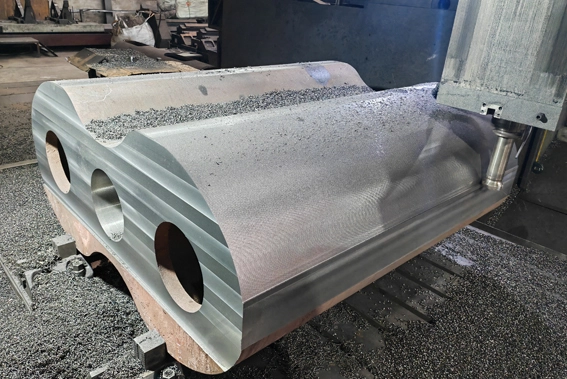Understanding Austempering and ADI Production
1. Material Base – Ductile Iron:
Ductile iron, also known as nodular iron or spheroidal graphite iron, is characterized by its graphite nodules that enhance ductility and toughness compared to gray iron. The base ductile iron offers excellent castability, machinability, and cost efficiency.
2. Austempering Process:
Austempering is a specialized heat treatment process that transforms the microstructure of ductile iron into ausferrite (a combination of acicular ferrite and carbon-stabilized austenite). The process involves the following steps:
· Heating (Austenitizing):
The ductile iron casting is heated to a temperature range of 850°C to 950°C (1,562°F to 1,742°F) to convert the microstructure to austenite.
· Quenching:
The casting is rapidly cooled (quenched) to an intermediate temperature of 250°C to 400°C (482°F to 752°F) in a molten salt or oil bath to avoid forming martensite.
· Isothermal Holding:
The casting is held at the intermediate temperature for a specific duration, allowing the austenite to transform into ausferrite, a structure that imparts excellent strength, toughness, and wear resistance.
· Cooling:
The casting is cooled to room temperature, preserving the ausferrite microstructure.
This heat treatment produces Austempered Ductile Iron (ADI), a material that offers exceptional performance compared to traditional cast irons and steels.
Key Properties of Austempered Ductile Iron (ADI)
1. High Strength-to-Weight Ratio:
ADI offers mechanical properties comparable to those of alloy steels, but at a lower density (10% lighter), making it an ideal lightweight material.
2. Exceptional Wear Resistance:
The ausferritic microstructure provides outstanding wear resistance, making ADI suitable for components subjected to abrasion and sliding wear.
3. Superior Toughness and Ductility:
ADI retains excellent impact resistance and ductility, even at high strength levels, ensuring reliability under heavy or shock loading conditions.
4. Excellent Fatigue Strength:
ADI components demonstrate high fatigue strength, making them ideal for cyclically loaded applications.
5. Cost-Effective Alternative to Steel:
ADI combines the castability of ductile iron with properties similar to heat-treated steels, reducing production costs due to fewer machining and fabrication steps.
6. Improved Noise and Vibration Damping:
ADI retains the vibration-damping properties of ductile iron, making it suitable for applications requiring noise reduction.
7. Design Flexibility:
The excellent castability of ductile iron allows for complex geometries, enabling engineers to optimize part design for weight and performance.
Applications of Austempered Ductile Iron Castings
Austempered Ductile Iron is widely used across various industries due to its unique combination of strength, toughness, wear resistance, and cost-effectiveness. Key applications include:
1. Automotive Industry:
· Gears and Transmission Components:
ADI gears, pinions, and transmission parts offer high wear resistance, fatigue strength, and toughness, making them ideal for heavy-duty vehicles and industrial machinery.
· Suspension Components:
Control arms, knuckles, and suspension brackets benefit from ADI’s lightweight strength, reducing overall vehicle weight and improving fuel efficiency.
· Crankshafts and Camshafts:
ADI crankshafts provide excellent strength and fatigue resistance for high-performance engines.
2. Construction and Earthmoving Equipment:
· Buckets, Teeth, and Wear Plates:
ADI components in excavators, loaders, and earthmoving machines offer superior wear resistance and durability in abrasive environments.
· Track Shoes and Drive Sprockets:
ADI is used for crawler tracks, sprockets, and rollers, where high fatigue strength and impact resistance are critical.
3. Agricultural Machinery:
· Plowshares and Tillage Tools:
ADI’s wear resistance ensures a longer service life for agricultural tools that experience significant abrasive wear in soil conditions.
· Harvester Components:
Components such as gears, sprockets, and shafts in harvesters benefit from ADI’s durability and resistance to fatigue.
4. Mining and Heavy Industry:
· Wear Parts and Liners:
ADI castings are used in crushers, hoppers, and grinding mills where high abrasion resistance is essential.
· Drill Bits and Cutting Tools:
ADI’s combination of toughness and wear resistance makes it suitable for drilling and cutting tools in mining applications.
5. Railway Industry:
· Brake Components and Wheels:
ADI wheels and brake components provide a durable and wear-resistant solution for rail vehicles, ensuring reliable operation under high loads.
· Track Components:
ADI components such as rail clips and clamps exhibit excellent fatigue resistance and strength in rail applications.
6. Wind and Power Generation:
· Gearboxes and Wind Turbine Components:
ADI gears and shafts used in wind turbines offer excellent fatigue strength, wear resistance, and reliability for long-term performance.
7. Industrial Machinery and Tools:
· Pulleys, Rollers, and Bearings:
ADI is widely used in industrial machines due to its ability to resist wear, fatigue, and impact loading.
· Tools and Dies:
ADI offers a cost-effective, durable solution for dies, molds, and tools requiring both strength and wear resistance.
Advantages of Austempered Ductile Iron Over Traditional Materials
· Compared to Steel:
ADI provides similar mechanical properties but is lighter and more cost-effective due to its castability and reduced machining requirements.
· Compared to Gray Iron:
ADI offers significantly higher strength, toughness, and wear resistance while retaining the damping capacity of traditional cast irons.
· Compared to Other Cast Irons:
The austempering process transforms ductile iron into a material with exceptional performance, surpassing conventional heat-treated cast irons in both strength and durability.
Why Choose Our ADI Castings?
1. Expertise in Austempering:
Our advanced heat treatment processes and skilled engineers ensure consistent quality and optimal material properties in every ADI casting.
2. State-of-the-Art Facilities:
We utilize modern heat treatment equipment to achieve precise control over the austempering process, delivering reliable and high-performance components.
3. Customized Solutions:
We work closely with customers to develop ADI solutions tailored to their specific applications, ensuring the best combination of strength, durability, and cost-efficiency.
4. Quality Assurance:
All our ADI castings undergo rigorous quality testing, including hardness, microstructure analysis, and mechanical property verification, to meet industry standards and customer specifications.
 English
English  Deutsch
Deutsch  français
français  русский
русский  فارسی
فارسی  العربية
العربية  Español
Español  日本語
日本語  한국어
한국어  italiano
italiano  português
português  dansk
dansk  Suomi
Suomi 










